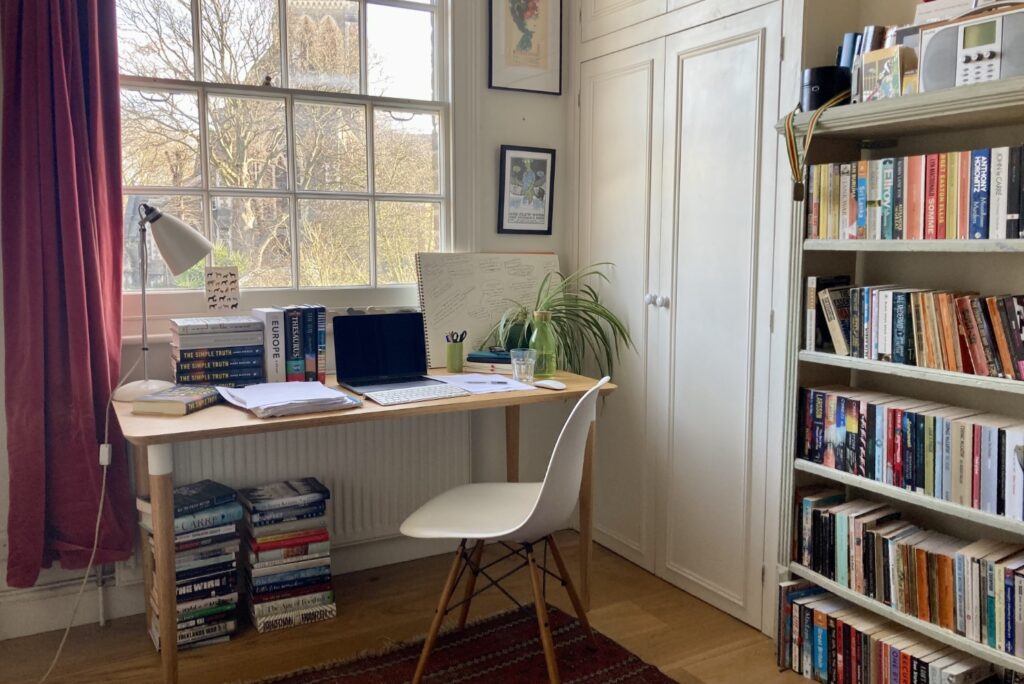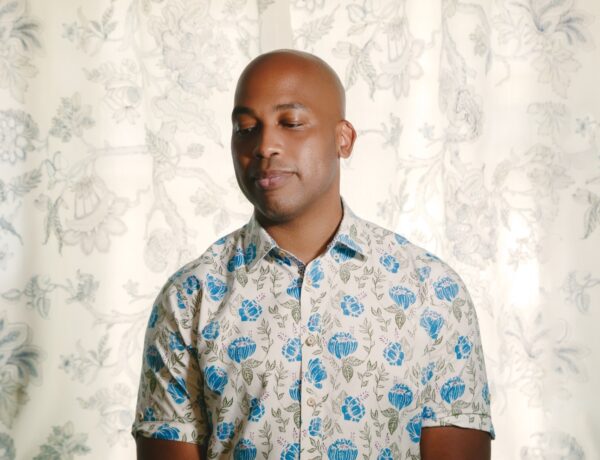James Buckler is a British author currently residing in London. He has a rich background of living in different parts of the world, including the south-west of England, the USA, and Japan.
He has a passion for books, stories, and films, particularly the gripping and twisty narratives of classic Hollywood cinema and British crime novels. Buckler studied Film, Video and the Photographic Arts at the University of Westminster, and has extensive experience in the film and TV industry, having worked as a post-production specialist for MTV and BBC Films.
In 2017, he published his critically acclaimed debut novel, Last Stop Tokyo, and his second novel, The Simple Truth, was released in January 2023.
Each week, we publish a new daily writing routine from a famous author. Subscribe to our newsletter so you don’t miss out!
Hi James! We’re delighted to have you as a guest on Famous Writing Routines. For our readers who may not be familiar with your work, could you please give us a brief introduction to yourself?
Hi there yourself! It’s an honour to be featured on Famous Writing Routines. I’m James Buckler, author of two fast-paced, twisty crime thrillers, Last Stop Tokyo, and my latest book, The Simple Truth. I currently live in London, but I’ve also had the pleasure of spending quite a few years in both San Diego, California and Tokyo, Japan. My background is in film and television as a post-production specialist, which means a lot of hours sat in dark rooms, staring at screens – not especially glamorous but an amazing way to learn the craft of filmmaking.
Can you tell us about your background in film and TV and how it has influenced your writing, specifically in terms of your debut novel, Last Stop Tokyo?
I was lucky enough to work at some really great film companies where I learned a lot about the entire production process, especially the hard work involved in developing ideas and the writing and re-writing of scripts. I was always in awe of the writers I worked with, so I watched and learned and gathered tips from some really talented people over the years.
The techniques they taught me are amazingly useful in writing novels: scenes work best when they start late and finish early; every sentence has to serve a purpose; an interesting character has to ‘want’ something significant and be proactive; a writer’s mantra is ‘conflict, tension and jeopardy’.
I love the attitude that shooting a film is expensive so every second counts. Good screenwriting is lean and spare and efficient. That spirit rubbed off on me over the years and I found that I wrote in this style naturally when I sat down to begin my debut novel, Last Stop Tokyo.
It was an idea that had been floating around in my head for a few years – the Tokyo set story of a couple, Alex and Naoko, and how their cultural differences lead to their downfall. I’d lived in Tokyo for a few years in my twenties and had a mountain of notes and stories that I’d written down at that time. Crazy bars and clubs I’d visited. Scary gangster tales I’d been told. All interesting material that I could use to begin building a story.
I took this first-hand experience and shaped it into a fully-fledged crime thriller with a mountain of twists and action. I don’t write a great deal of ‘inner voice’ material. I like to write as if a camera is watching the characters closely as the action unfolds. Everyone who reads it says Last Stop Tokyo would make a great movie. I happen to fully agree!
How has your experience living in different places, such as the USA and Japan, influenced your writing?
Living in both of those places has been a huge influence on me, especially the book culture from both countries. The American authors I love have perfected the art of snappy, gritty stories that are ‘street smart’ but with great writing. Think Don Winslow, Elmore Leonard and Walter Mosley. I love their sharp characters and cracking dialogue. They all write addictive page turners that you can’t put down. This was the style I wanted for The Simple Truth. The book is super-fast paced with a lot of different characters and multiple story lines that finally twist together.
From the Japanese writing I’ve found, such as The Thief by Fuminori Nakamura, I took a slightly different message. The Japanese are masters of deep thinking disguised by great action. For my debut, I borrowed the concept of mono no aware, which sounds very dry but is actually quite simple and makes for some really interesting storytelling. It’s about the bittersweet way life often turns out for people. How our deepest desires slip away from us the harder we reach for them. This was the foundation of the narrative in Last Stop Tokyo. The twists of the crime story and the ‘noir’ tone were fuelled by this idea.
On a personal level, I highly recommend the benefits of getting away from everything that’s familiar and immersing yourself in a new culture. My time in the US was a life changing experience, especially the amazing people I met in California. I’m a surfer so San Diego was like heaven to me. I really miss living there, if I’m honest. Moving to Japan was a real culture shock. Tokyo is unreal – the vastness of the city is mind blowing. I’m glad I did a lot of travelling when I was younger. Now I’m a writer so I spend all my time chained to a desk!
Discover the daily writing habits of authors like Stephen King, Neil Gaiman, and Gillian Flynn with Famous Writing Routines Vol. 1 and learn how to take your writing to the next level. Grab your copy today!
You’ve always been fascinated by the “gripping, twisty narratives” of classic Hollywood cinema and British crime novels. How do you approach the task of building suspense and tension in your own work?
I like to take my characters and throw them straight into situations of maximum jeopardy and see what they can do to try and survive. The best source of narrative propulsion is a character trying to stay alive while solving a fiendishly difficult task.
It’s a very old storytelling technique that works perfectly in crime thrillers. Hollywood’s main addition to this was to make sure the main characters looked unbelievably cool while in danger, like Humphrey Bogart and Lauren Bacall in The Maltese Falcon. Only American films had the chutzpah to pull off characters like that.
I really like films such as Miller’s Crossing and Devil in a Blue Dress, because they perfect this high wire act that began in early Hollywood. I love the idea of characters who are attacked from all sides, but who weather the blows while looking like a million dollars. Hollywood heroes who are just ice cold.
The films I mentioned took their inspiration from the books of Dashiell Hammett and Raymond Chandler, who took theirs from Edgar Wallace and Arthur Conan Doyle. So there’s a through line from Great British crime novels to American fiction to classic Hollywood. This is the kind of punchy storytelling I love.
What does a typical writing day look like for you?
I’m the proud owner of a Labrador named Marnie, so my day starts with an early walk. This is the perfect time to let my mind wander and work out what I’m going to write when I get to my desk. Like all writers, I’m pounding coffee from the moment I sit down and start typing.
I drink so much coffee that I’ve had to switch to decaf. I like to spend the morning just motoring as fast as possible, getting as many words down as I can without looking back to question or self-edit in case the demon inner voice of criticism kills my momentum.
After a few hours of this, my fingers become tired so I go back and read my morning’s work. After I’ve run around the house screaming in frustration for five or ten minutes, I calm down and work out how to re-write the material into something readable. It’s this process that’s actually the most rewarding. The part where you figure out what it is that you’re actually trying to say; what the point of the scene or chapter really is.
This is where my random thoughts and scribblings start to become the sculpted blocks that will eventually make up an engaging, entertaining story. Hopefully one where all the parts work together to create a satisfying world for the reader to escape into.
I write for as long as I have ideas in my mind that I can use, usually about six or seven hours. By then, I’d exhausted whatever material I’d dreamed up on that morning’s dog walk. If I feel like I’m wandering off into the woods at any point, then I know whatever I write from that moment will end up in the waste bin. On those days, I stop a little earlier and look up and remember there’s a real world outside my door. The dog’s always happy if I knock off a bit sooner and take her out for a stroll.
Can you talk about any specific techniques or tools you use to help with the writing process, such as outlining, character development, or research methods?
I read a lot of newspapers and news sites from around the world. I think it’s best to situate your material in current events. The Simple Truth has a subplot about green energy production which came from keeping up with current affairs.
I take as many notes as I can throughout any given day. I write everything down, no matter how weird or wacky the thought might be in case it turns out to be a killer idea. I carry a notebook and a pen everywhere and I type endless notes to myself on my phone when I’m riding on the Tube or out walking the dog.
One method I use in the initial stages of a project is to draw out a schematic diagram on a huge sheet of paper showing all of the characters and how they relate to each other. I sketch out the connections the characters have that are ‘known’ – the surface relationships and identities that might prove to be false.
Then I sketch out all of the hidden, secret connections they have – the true motivations and ‘wants’, buried beneath the characters’ outward appearances and their real identities that will be revealed as the story unfolds. I’m not sure if there’s a better way of doing this than drawing it all out. There’s no way I could keep it all in my head and not lose track of what’s really going on in the story.
I pin this crazy diagram onto the wall of the room where I write and stare at it for hours, like a madman, while I try to figure out all of the nasty and dangerous things these people will do to one another to get what they want. What a great job to have!
For more in-depth research, I use the British Library which is an amazing resource we’re fortunate to have in London. It’s also a fantastic place to work that’s free and quiet and has a real sense of calm toil in its reading rooms. It’s a bit of a home from home for me.
Apart from this, I use the usual research sources – Google and Wikipedia. And I love the good old-fashioned hitting the streets, shoe leather method of research. I spent a lot of time snooping about London to get a real sense of place for the locations in The Simple Truth.
How do you manage your time and stay productive while working on multiple writing projects at the same time?
There’s a writer character in Rosemary’s Baby who uses two separate typewriters as he beavers away on different manuscripts, so I wish I could say I do that. That would be a homage to a great book. The truth is that whenever I lose focus or motivation, I remember some of the tough times I spent working at jobs I really hated but had no choice. That always makes me really grateful that I’m able to write for a living.
I write every day, even if getting the words down is like tearing out my own teeth. I always have more ideas for stories than I could ever possibly finish so I have to work quickly or I worry they’ll dry up. It’s the forward momentum that generates more ideas, which generates more momentum and so on. Oh, and I don’t drink. That’s one false myth of writerly creativity that I saw through early on.
If you could have a conversation with an author throughout history about their writing routine and creative process, who would that person be?
Georges Simenon would be a fascinating person to speak to. He managed to write hundreds of novels under different names, including over seventy featuring Inspector Maigret. The ability to dream up such a great character and such an array of diverse storylines for so long must be like having a superpower.
Simenon also had a colourful life that led him around the world, getting into some very deep trouble on the way. He’s an interesting character in his own right. Some film writers I’d love to speak to would be Joan Harrison and Frances Marion. They were both very prolific and very talented and were nominated for early Academy Awards when it was tough for women to get a break in the film industry.
I’d love to know what you’re reading at the moment. What have been some of your favourite books you have read recently?
I always have several books on the go at once. Right now I’m ripping through Thirteen by Steve Cavanagh, which is so good that it’s impossible to put down. I recently finished Heat 2 by Meg Gardiner and Michael Mann. I’m a huge fan of the film Heat so this was a book I opened with a little trepidation, anxious about being disappointed after such a long wait, but it’s fantastic.
Every page is tense and atmospheric, adding new dimensions to a classic story. When I find a writer I like, I tend to read everything they’ve published – Lawrence Osborne is a recent find whose books are superb, especially The Forgiven. Last year I read Len Deighton for the first time and was knocked out by the quality of his storytelling. He published twenty seven books in all and I’ve worked my way through nine, so I’ve got a long way to go until I’ve mined that seam.
What does your current writing workspace look like?
It’s surprisingly tidy at the moment. I’m starting something new so I’m just beginning the process of scribbling and sketching out the shape of the new plot. Soon I’ll have paper flying everywhere and notes scattered around at random. I try out a lot of ideas which get discarded along the way, so I create a lot of debris as I go. Also, I keep everything – no notes or sketches are thrown away in case they might contain a single good idea. This means that I usually live under a mountain of chaos. I also play the drums and my electronic drum kit is at the back of my writing room. When I’m stuck on a particular passage, I sit down and whack the drums for a good ten minutes. It releases a lot of frustration and creativity.

Affiliate disclaimer: Some links on this website are affiliate links. We may earn a small commission if you make a purchase through these links, but only promote products we truly believe in. We disclose affiliate links and give honest reviews.



No Comments